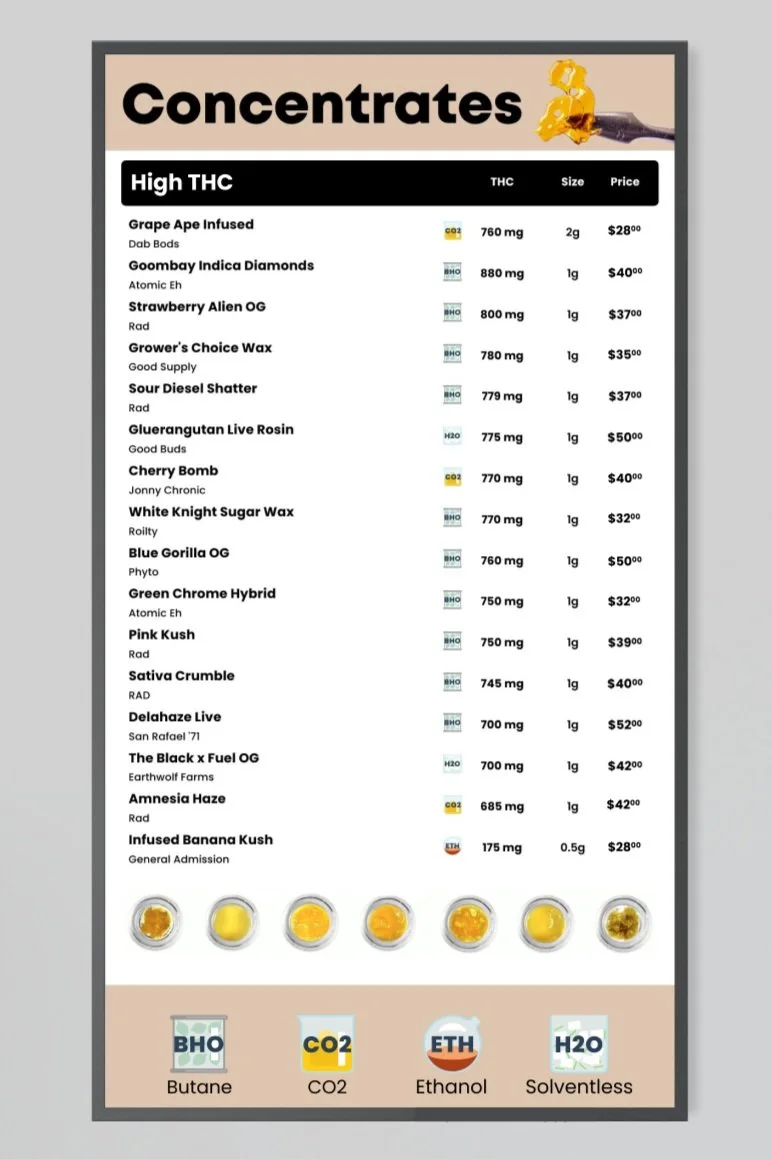Demystifying Cannabis Extraction Methods: A Simplified Guide
Cannabis extraction is a crucial process that unlocks the potent compounds found within the plant. From cannabinoids to terpenes, these compounds play a significant role in the therapeutic and recreational effects of cannabis products. In this blog post, we'll break down the various extraction methods used in the cannabis industry, offering a simplified guide to help you understand the basics of each technique.
Curious about other extracted products? Click here to learn about everything from Resin to CBD Isolates.
Solvent-Based Extraction: Unveiling the Power of Solvents
For thousands of years extraction methods were all solventless. Then as innovation in the mining industry started to ramp up believe it or not mining extraction technology made it’s way over to Cannabis processing.
Solvent-based extraction methods involve using a solvent to separate cannabinoids and other compounds from the cannabis plant material. Typical solvents include ethanol, hydrocarbons (butane and propane), and supercritical carbon dioxide (CO2). Here's a closer look at two popular solvent-based extraction methods:
Hydrocarbon Extraction: Harnessing the Power of Hydrocarbons
Hydrocarbon extraction involves using solvents like butane or propane to dissolve cannabinoids and terpenes from the plant material. After the extraction process, the solvent is purged to leave behind a concentrated oil. This method produces high-quality extracts with rich cannabinoid and terpene profiles.
CO2 Extraction: Supercritical Precision
Supercritical CO2 extraction uses pressurized carbon dioxide to create a supercritical state, where CO2 behaves as a gas and a liquid. This versatile method allows precise control over temperature and pressure, resulting in targeted extraction of specific compounds. CO2 extraction is favored for its ability to yield clean and consistent extracts.
Solventless Extraction: Going Chemical-Free
Solventless extraction techniques prioritize purity and avoid the use of chemical solvents. Instead, these methods rely on mechanical or heat-based processes to separate valuable compounds from the plant material:
Rosin Pressing: The Heat-Powered Approach
Rosin pressing involves applying heat and pressure to cannabis flower or hash to squeeze out cannabinoids and terpenes. The resulting rosin is a sticky substance rich in essential compounds. This method is popular among home enthusiasts due to its simplicity and chemical-free nature. What’s the difference between Rosin and Resin? Glad you asked! You can read here about the difference.
Ice Water Hash: The Cold Separation
Ice water hash extraction uses cold water and agitation to separate trichomes (resin glands) from the plant material. The trichomes are then collected and dried to produce a concentrated hash product. This method is gentle on the plant and preserves the delicate terpene profiles.
Distillation: Purifying the Essence
Distillation is a refinement process that involves heating and cooling to separate different compounds based on their boiling points. This method is often used to purify cannabis extracts and isolate specific cannabinoids:
Short Path Distillation: Purity Through Evaporation
Short-path distillation utilizes temperature-controlled evaporation to separate compounds based on their boiling points. This method commonly isolates cannabinoids like THC and CBD, resulting in highly pure and potent distillates.
Terpene Extraction: Capturing Aromas and Flavors
Terpene extraction focuses on isolating the aromatic compounds responsible for the unique flavors and aromas of cannabis:
Steam Distillation: Gentle Terpene Extraction
Steam distillation involves passing steam through plant material to release terpenes, which are then condensed into an aromatic oil. This method preserves the delicate terpene profiles without damaging their molecular structure.
The World of Extraction
Cannabis extraction methods encompass a diverse range of techniques, each with its own advantages and applications. From solvent-based to solventless distillation to terpene extraction, the world of extraction offers a variety of options to capture the essence of the cannabis plant. As the industry continues to evolve, understanding these methods empowers consumers and enthusiasts to make informed choices about the cannabis products they enjoy.
Showing Extraction methods on your menus!
The BudSense platform makes it easy and fun to highlight extraction methods on your menus.
Badges enable you to add visual icons showing different extraction methods, including Butane, Carbon Dioxide, Ethanol, Isopropyl, or Solvent.
Furthermore, as this menu shows, you have the flexibility to employ custom section titles. This allows you to effectively convey the specific extraction methods utilized in the production of the cannabis products you've thoughtfully selected and curated for your menu.
Cannabis extraction methods encompass a diverse range of techniques, each with its own advantages and applications. From solvent-based to solventless distillation to terpene extraction, the world of extraction offers a variety of options to capture the essence of the cannabis plant. As the industry continues to evolve, understanding these methods empowers consumers and enthusiasts to make informed choices about the cannabis products they enjoy.
Book a demo today with us to find out more about how BudSense can help you accomplish your merchandising goals.












In this Q&A, we asked Ethan, who leads sales at BudSense, to share what he hears most often in demos and sales calls:
Which features grab attention right away
What the “wow moment” looks like depending on the retailer
Why trust is always the biggest concern in cannabis tech
And how BudSense’s print menus keep blowing people away